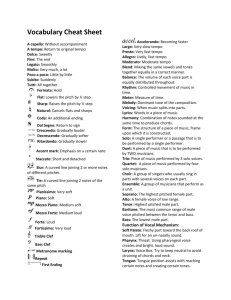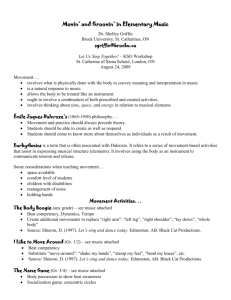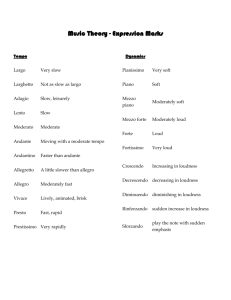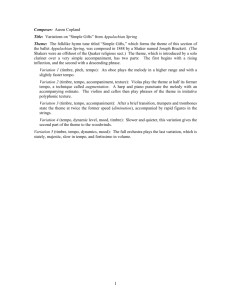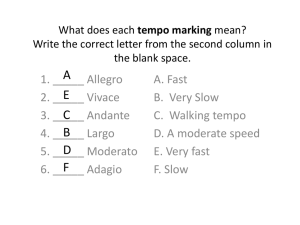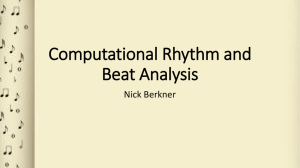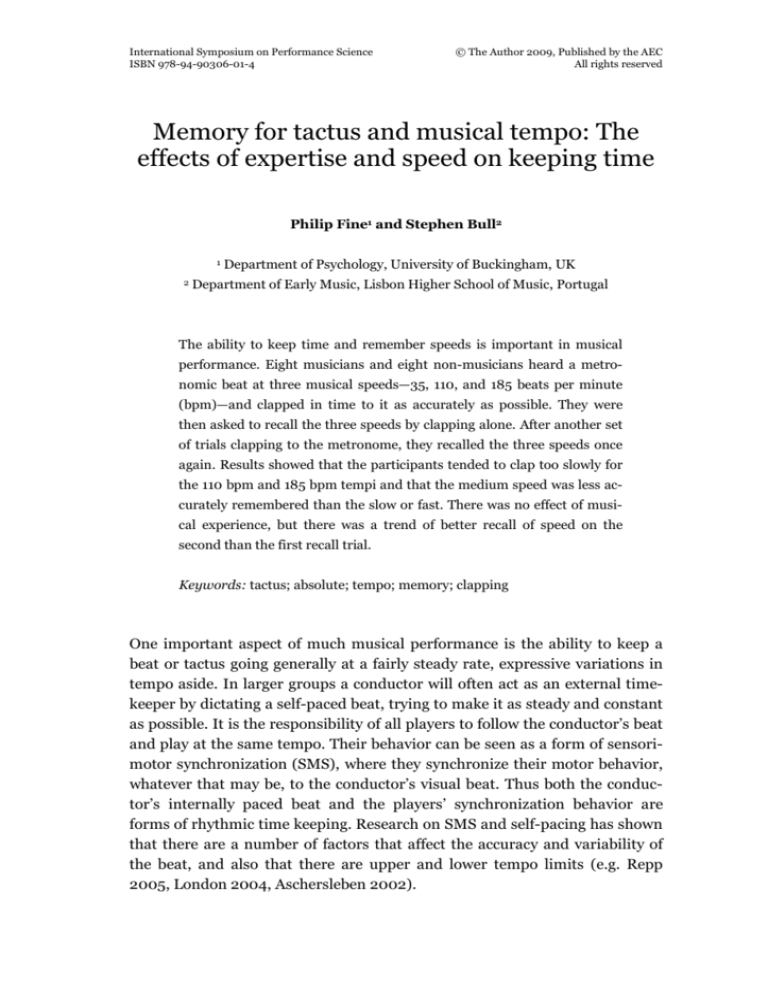
International Symposium on Performance Science
ISBN 978-94-90306-01-4
© The Author 2009, Published by the AEC
All rights reserved
Memory for tactus and musical tempo: The
effects of expertise and speed on keeping time
Philip Fine1 and Stephen Bull2
1
2
Department of Psychology, University of Buckingham, UK
Department of Early Music, Lisbon Higher School of Music, Portugal
The ability to keep time and remember speeds is important in musical
performance. Eight musicians and eight non-musicians heard a metronomic beat at three musical speeds—35, 110, and 185 beats per minute
(bpm)—and clapped in time to it as accurately as possible. They were
then asked to recall the three speeds by clapping alone. After another set
of trials clapping to the metronome, they recalled the three speeds once
again. Results showed that the participants tended to clap too slowly for
the 110 bpm and 185 bpm tempi and that the medium speed was less accurately remembered than the slow or fast. There was no effect of musical experience, but there was a trend of better recall of speed on the
second than the first recall trial.
Keywords: tactus; absolute; tempo; memory; clapping
One important aspect of much musical performance is the ability to keep a
beat or tactus going generally at a fairly steady rate, expressive variations in
tempo aside. In larger groups a conductor will often act as an external timekeeper by dictating a self-paced beat, trying to make it as steady and constant
as possible. It is the responsibility of all players to follow the conductor’s beat
and play at the same tempo. Their behavior can be seen as a form of sensorimotor synchronization (SMS), where they synchronize their motor behavior,
whatever that may be, to the conductor’s visual beat. Thus both the conductor’s internally paced beat and the players’ synchronization behavior are
forms of rhythmic time keeping. Research on SMS and self-pacing has shown
that there are a number of factors that affect the accuracy and variability of
the beat, and also that there are upper and lower tempo limits (e.g. Repp
2005, London 2004, Aschersleben 2002).
168
WWW.PERFORMANCESCIENCE.ORG
Keeping in time is clearly relevant to musical performance, and responding regularly (e.g. tapping or clapping) is a commonly used method of measuring SMS ability. The asynchrony between the given beat and the
participant's response indicates their accuracy. Previous research has suggested this SMS accuracy is affected by various factors, including the tempo of
the tactus and the participant's musical expertise (Repp 2005). Research
when the beat disappears but the participant has to keep tapping at the same
tempo has also been conducted. This is called continuation tapping, and typically appears to show an approximately 12 s period of maintained control
(Chen et al. 2002).
Another important skill in performing music in most cultures is the ability
to set and control the tempo: too fast and the piece may be unplayable and
detail glossed over; too slow and perceptual and structural coherence and
performers’ breathing (if relevant) may suffer. Conductors and unconducted
performers (often soloists) must be able to start a piece at the right tempo,
and better performances tend to show less evidence of tempo drift or unplanned corrections or fluctuations in speed. Although there is much evidence
concerning absolute pitch (AP), the ability to recall at will a pitch from long
term memory (e.g. Ward 1999), there is less on “absolute tempo” (AT), the
ability to remember a particular beat speed (i.e. tactus) and recall it when
required for performance.
Previous research has tested tempo recall for pieces in long term memory.
Levitin and Cook (1996) had participants sing popular songs with which they
were familiar, and 72% of the productions were within 8% of the original
tempo. Trainor et al. (2004) also showed that infants preferred a familiar
piece provided the tempo was not changed by more than 25%, suggesting a
long-term tempo memory, though probably less accurate than that of adults.
The aims were, therefore, twofold. First, we investigated the effect of musical expertise on people's accuracy for carrying a tactus and remembering a
tempo in the absence of a specific piece of music, both measured by clapping
in time. It was hypothesized that expert musicians would be more accurate
both in their tapping accuracy and in their long term memory for tempo than
non-musicians. Secondly, we investigated the effect of different speeds of a
given tactus on tapping in time and, in particular, on tempo recall.
METHOD
Participants
There were 16 participants, split into two equal groups of expert musicians
(professional, semi-professional, and student) and those whose professional
INTERNATIONAL SYMPOSIUM ON PERFORMANCE SCIENCE
169
life did not involve music. The musicians (5 M, 3 F) were aged between 20
and 48 years (mean=30.8). Some were specialists either in conducting or in
percussion playing. Non-musicians (6 M, 2 F) were aged between 23 and 74
years (mean=49.9), and had no musical training beyond school, though two
had choral singing experience, and one was a self-taught drummer.
Materials
Metronomic recordings of three different tempi: quarter note=35 bpm corresponding to interstimulus interval (ISI) of 1714 ms, quarter note=110 bpm
corresponding to ISI of 545 ms, and quarter note=185 bpm corresponding to
ISI of 324 ms, were made on a MacBook 4.1 (2.1 GHz processor) in the software Finale, using the sound of a woodblock. This was transferred to a CD,
along with instructions, and the recordings were played to participants in
various testing locations. Attention was given to minimizing ambient sound
and to avoiding the presence of aural or visual rhythmic stimuli in the room.
Participants’ productions together with the metronomic stimuli were recorded on the same MacBook computer and converted to AIFF format files.
These were then analyzed using the software program Praat (version 5.1.04)
to measure times between claps (Boersma and Weenink 2009).
Procedure
There were two tasks. First, participants were asked to clap, synchronizing as
closely as possible with a recorded beat (the beats on the recording disappeared and reappeared, see below). In the second task, participants were
asked to reproduce from memory the speeds of the original recording. The
three speeds of 35, 110, and 185 bpm (“slow,” “medium,” and “fast,” respectively) were chosen so as not to be related to each other by any simple proportion. Tempo order was counterbalanced between participants.
In the first section of each test, participants were asked to listen to the recording of beats, to join in after hearing the first four beats, and to continue
clapping until told to stop. Some beats on the metronomic stimulus were absent and the participants were informed of this but asked to continue clapping nonetheless. In all tests, there were 8 beats present, 4 absent, 4 present,
4 absent, 8 present, 8 absent, 8 present, and 8 absent. Thus, clapping regularity in both the presence of a beat (SMS) and its absence (continuation)
were tested. Participants performed the above test at the three speeds and
then repeated them in the same order. A gap of about 30 s was left between
tests. They were then asked to fill in a questionnaire covering age, gender,
and musical experience. Approximately 4 mins were given for this.
170
WWW.PERFORMANCESCIENCE.ORG
Figure 1. Mean, minimum, and maximum recorded clapping tempi (bpm) as a function
of the given tempo. The target tempo is shown by the solid line. (See full color version at
www.performancescience.org.)
Next, participants’ memory for the three speeds was tested. They were
asked to clap at the slow, medium, and fast speed, in the same order they had
already been tested on, both beginning and ending when indicated. A total of
about 32 claps were recorded for each trial. After the recall test of each speed,
the first test (clapping with the recorded beats) was repeated, followed, after a
1 min pause, by the test of memory once again. A complete testing session
took approximately half an hour per participant.
RESULTS
The present article focuses on the participants’ tempo memory data. Overall,
participants were fairly good at recalling the slow tempo but tended to underestimate both the medium and fast tempi (i.e. clapping too slowly) quite substantially (see Figure 1). However, their recall for these tempi was generally
better on the second recall trial, underestimating less (see Table 1). When the
musicians and non-musicians were analyzed separately, the musicians were
generally found to recall the medium and fast tempos more accurately than
the non-musicians, underestimating the speeds less (see Table 2). A 3-way
Analysis of Variance (ANOVA) with tempo, trial, and musical experience as
factors was conducted on the mean error as a percentage of the target tempo.
INTERNATIONAL SYMPOSIUM ON PERFORMANCE SCIENCE
171
Table 1. Clapping tempo (bpm) in the recall tests (SD in brackets.)
Tempo
Slow
Target tempo
35
Recall 1
Recall 2
34.7 (4.86)
38.5 (13.36)
Medium
110
75.0 (23.06)
87.8 (28.52)
Fast
185
156.9 (35.02)
166.0 (23.75)
Table 2. Clapping recall tempo (bpm) as a function of musical training (SD in brackets).
Target tempo
Slow (35)
Medium (110)
Fast (185)
Musicians
Non-musicians
Recall 1
Recall 2
Recall 1
Recall 2
32.0 (3.24)
32.9 (3.02)
37.0 (5.01)
43.5 (17.05)
74.5 (24.91)
97.5 (34.43)
75.4 (24.85)
80.5 (15.86)
165.9 (21.46)
175.0 (22.95)
146.7 (45.90)
157.1 (23.75)
Tempo was highly significant (F2,22=10.96, p<0.01): Bonferroni post-hoc tests
showed that the medium tempo was recalled significantly more poorly than
either the slow or fast tempi (as can be seen from the mean and target tempo
lines in Figure 1). Trial showed a non-significant trend (F1,22=4.14, p<0.07), in
that the tempo error was smaller in the second trial than the first. Musical
experience was not found to be a significant factor.
DISCUSSION
Overall there was large variation in remembered tempo, particularly showing
underestimation (see Figure 1), but the slow and fast tempi were recalled
better than the medium tempo, at least in terms of percentage errors. It is
unclear why fast speeds were better remembered than the medium speed,
although future tests may study the relevance of remembering fewer tempi in
a test. However, musical experience was not found to affect tempo recall,
there being no difference between the two groups. This may be because three
of the non-musicians in fact had some musical experience (see “Participants”), diluting the difference between groups. Tempo memory was generally better on the second trial, after the participants had carried out more
SMS/continuation tasks. The continuation claps can be thought of as testing
short-term memory, with in effect immediate feedback, so this was not surprising.
In future research, we intend to ask participants to clap to tempi identified by name (e.g. “quick march” and “slow dirge”) or bpm (e.g. quarter note=
172
WWW.PERFORMANCESCIENCE.ORG
65 or 140), rather than the terms “slow,” “medium,” and “fast”. We will vary
the number of tempi included in tests and accurately control the time elapsing before participants are required to reproduce a tempo from memory. We
also intend to include distracter tasks, which may affect mental rehearsal, and
compare the use of a beat pad with clapping, to reveal the relevance of the
“choreographic” element of clapping.
Acknowledgments
Thanks to Derrick Walford for assistance with the data measurement using Praat.
Address for correspondence
Philip Fine, Department of Psychology, University of Buckingham, Hunter Street,
Buckingham MK18 1EG, UK; Email: philip.fine@buckingham.ac.uk
References
Aschersleben G. (2002). Temporal control of movements in sensorimotor synchronization. Brain & Cognition, 48, pp. 66-79.
Boersma P. and Weenink D. (2009). Praat: Doing Phonetics by Computer (version
5.1.04). Computer program, available online at www.praat.org.
Chen Y., Repp B H, and Patel A. D. (2002). Spectral decomposition of variability in
synchronization and continuation tapping: Comparisons between auditory and visual pacing and feedback conditions. Human Movement Science, 21, pp. 515-532.
Levitin D. J. and Cook P. R. (2006). Memory for musical tempo: Additional evidence
that auditory memory is absolute. Perception & Psychophysics, 58, pp. 927-935.
London J. (2004). Hearing in Time. Oxford: Oxford University Press.
Repp B. H. (2005). Sensorimotor synchronization: A review of the tapping literature.
Psychonomic Bulletin and Review, 12, pp. 969-992.
Trainor L. J., Wu L., and Tsang C. D. (2004). Long-term memory for music: Infants
remember tempo and timbre. Developmental Science, 7, pp. 289-296.
Ward W. D. (1999). Absolute pitch. In D. Deutsch (ed.), The Psychology of Music (pp.
265-298). San Diego, California. USA: Academic Press.


